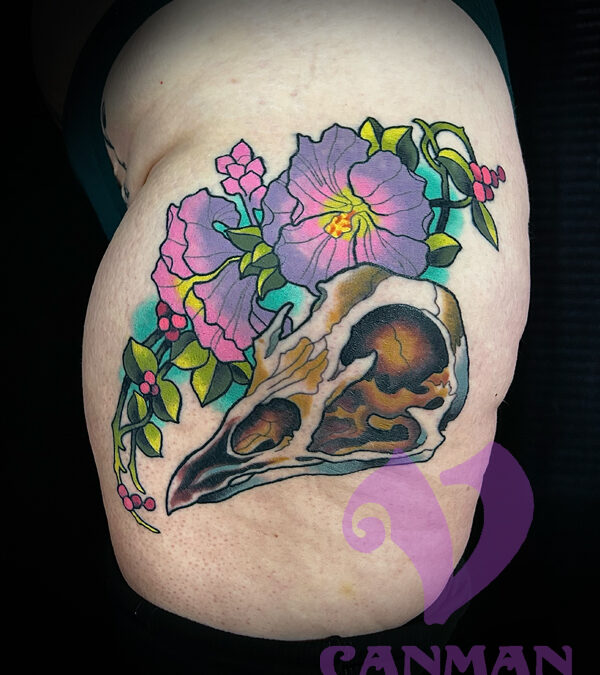This bird skull tattoo was a fun project and took 3 hrs. to complete.
The client is a fan of animal skulls.
In addition, she wanted to add a floral arrangement to pretty it up.
Are you looking for your own unique Bird skull tattoo?
Go to our Tattoo Request form to get your project started!
Bird skull symbology
A bird skull tattoo can represent transformation.
Also, It can mean freedom, or the link between life and death.
About bird skulls
Bird skulls are generally lightweight, as birds need to minimize their overall body weight for efficient flight.
Many bones in the skull are fused or have air-filled spaces.
These are called pneumatic bones, which contribute to this lightweight structure.
The beak, or bill, is a prominent feature of a bird’s skull.
Beaks are adapted to the bird’s diet and feeding behavior.
However, they can vary significantly in shape and size.
They range from the long, pointed beaks of hummingbirds for feeding on nectar, to the strong, hooked beaks of raptors for tearing flesh.
Many bird species exhibit cranial kinesis, which is the ability to move the bones of the skull relative to each other.
Therefore, flexibility is particularly important during feeding.
This allows birds to manipulate their beaks and consume a variety of food items.
Some bird species have elaborate skull ornamentation.
To clarify, these crests or casques, can be important for species recognition and courtship displays.
The position of the eyes in a bird’s skull is often an adaptation related to its lifestyle.
For example, predators like raptors typically have forward-facing eyes to facilitate binocular vision.
This aids in hunting and capturing prey.
Herbivorous birds might have eyes placed more on the sides of their heads to detect threats from different directions.
Birds often have well-developed sensory structures in their skulls.
As a result, the braincase houses the brain, and the orbits protect the eyes.
Additionally, the skull may contain structures related to hearing and balance.
There is a wide variety of bird species, and their skulls can vary greatly in shape and size.
most importantly, adaptations in the skull are often related to the bird’s ecological niche.
Similarly, the structure of a bird’s skull can provide insights into its taxonomic classification.
Understanding the structure and adaptations of bird skulls is essential for gaining insights into their biology, behavior, and evolutionary history.
In conclusion, researchers often study bird skulls to learn more about the diversity and adaptations of avian species.
